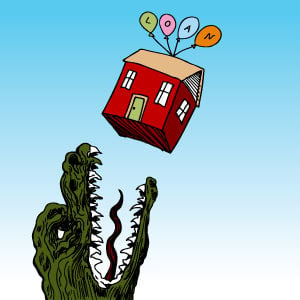Buying a home is one of the most significant financial decisions you’ll ever make, but the process...
How Mortgages Work
Get the low-down on how mortgages work, plus info on costs and options
The basics of how mortgages work
On a mortgage loan, your home serves as collateral. A mortgage lender loans you the money that you agree to pay back with interest on a monthly basis over a set time period. If you fail to make payments, the lender may repossess (foreclose on) your home.
The down payment is the sum you pay upfront to reduce the amount you need to borrow. Down payments can be as large as you can comfortably afford — the only requirement is that they meet the loan’s minimum down payment requirement.
The more you put down, the less you need to finance, and the lower your monthly payment.
The traditional minimum down payment is 20 percent of the purchase price, but you can find mortgages that require much less money down — as low as 3 to 5 percent or in some cases, zero.
PITI: the payment breakdown
A monthly mortgage payment is composed of principal, interest, taxes, and insurance, or the PITI.
- Principal This is the total amount that you are borrowing.
- Interest This is amount of money the lender charges you for borrowing. It is calculated as a percentage of the total amount you're borrowing.
- Taxes The monthly amount needed to pay your property taxes is often put into an escrow or “holding” account. The escrow holder then pays the property taxes for you out of the escrowed funds, usually once a year.
- Insurance: Most mortgage lenders require the purchase of homeowners insurance to protect you and the mortgage lender against loss from fire, storms, theft, vandalism and other potential catastrophes. If you are making a down payment that is less than 20 percent of the purchase price, you may also have to buy private mortgage insurance, which protects the lender should you default on your payments.
Fixed rate mortgages and amortization
With a fixed-rate mortgage, your monthly payment remains roughly the same for the life of the loan. What changes monthly is the portion of the mortgage payment that pays down the principal. The gradual repayment of the original loan amount and the accumulated interest is called amortization.

If you look at an amortization schedule for a 30-year mortgage at a website such as www.amortization-calc.com, you will notice that borrowers pay a lot more interest than principal in the early years of the loan. For example, a $200,000 loan with a 5 percent interest rate requires a monthly payment of $1,074. During the first year, roughly $830 of each monthly payment goes toward paying interest. Just $244 goes toward paying down the amount you borrowed. Not until the 15th year does the principal payment exceed the interest amount.
The advantage of amortization is that you slowly pay back the interest over the life of the loan, rather than paying one large payment at the end. The downside of spreading the payments over 30 years is that you end up paying $386,512 for a $200,000 loan.
A long-term mortgage also means it will take longer to build up equity in the home (the amount the home is worth beyond what you owe on it), since you will be paying very little toward the principal of the loan for many years.
The good news is that you can deduct the interest payments from your taxes, and the value of your home will likely increase over the years, which both add to its overall investment value.
In addition to 30-year fixed rate mortgage loans, you can also find loans with shorter payment periods, including 20-year fixed-rate, 15-year fixed-rate and 10-year fixed rate.
These shorter-term loans offer the same advantages of a 30-year loan but are often offered at a lower annual interest rate, which means a quicker payoff and higher equity sooner, but the monthly payment will be higher.
Adjustable rate mortgages
An adjustable-rate mortgage (ARM) is a loan with an interest rate that changes, usually once a year, according to changing market conditions. ARMs can be attractive because the initial rate is typically much lower than a conventional 30-year fixed-rate mortgage.
Buyers who intend to sell their home in a few years often opt for this loan type, with hopes to sell their home before the rate jumps up to the 30-year rate or higher, but hopes don’t always become reality. This is where additional risk comes in. A change in the economy can make a job layoff possible or selling your home difficult, which can ultimately lead to foreclosure.
In addition to a one-year ARM, there can be a six-month ARM, a two-year ARM, and so on. One popular version is a five-year ARM, which carries a fixed rate for five years, then adjusts annually for the life of the loan.
Many ARMs also have limits as to how high your interest rate can go over the life of the loan, and how much it can increase over a specific period of time. Never sign up for an ARM that doesn’t include specified limits.
 A balloon mortgage offers you a low payment for 5-7 years, at the end of which you are responsible for the remainder of the principle.
A balloon mortgage offers you a low payment for 5-7 years, at the end of which you are responsible for the remainder of the principle.
Balloon mortgages
A balloon mortgage is a loan with a shorter term, typically five to seven years. It also offers a mortgage rate much lower than a 30-year loan. The payments are amortized as if it's a 30-year loan, so that you end up making low monthly payments for five years, but at the end of those five years, you owe the bank the remaining principal balance, which will not be much lower than the original loan amount. At that time, you must come up with the principal balance from your savings or other investments or by refinancing or selling your home. Otherwise the lender has the option to foreclose.
Reverse mortgages
Unlike other mortgages, reverse mortgages pay you, not the lender, for as long as you live in your home. These loans are designed for homeowners age 62 or older who need more cash flow, either via a monthly check that the lender sends to them or as a line of credit. Essentially, these homeowners are borrowing against the existing equity in their homes, but they don't have to pay the loan back as long as they don’t sell it or move out.
The downside to a reverse mortgage is that the closing costs can be very high, and taxes and mortgage insurance payments must still be made.
Federal Housing Administration (FHA), Veterans Administration (VA), and Rural Housing Service (RHS) Loans
Three federal government agencies work with lenders to offer discounted rates and loan terms for qualifying borrowers. They are the Federal Housing Administration (FHA), the Veterans Administration (VA) and the Rural Housing Service (RHS).
In most cases, these agencies don't actually lend money. Instead, they insure the loans made by a list of approved mortgage lenders. This insurance includes refinancing mortgages that have become unaffordable.
- If you have a less-than-ideal credit rating, you may find it easier to secure a loan from an FHA-approved lender. FHA loans require smaller down payments. In some instances, a family member or a charitable organization can provide a down payment. (Commercial loans do not allow others to provide your down payment.)
- Like FHA loans, VA-backed loans offer generous terms and relaxed requirements to qualified veterans, some with no money down.
- If you live in a rural area or small town, you may qualify for a low-interest loan through RHS. Unlike the other two agencies, RHS offers both guaranteed loans through approved lenders and direct government-funded loans.
QUICK TIP
Interest rate vs. annual percentage rate, or APR
In addition to quoted interest rates, you must also pay certain fees associated with the loan. These fees may include a loan origination fee, mortgage broker fees, loan discount points you can opt to pay in order to obtain a lower interest rate, insurance fees, settlement fees and attorney fees.
By law, lenders are required to disclose what the interest rate plus fees will actually cost you — referred to as the APR, or annual percentage rate. The APR will always be higher than your interest rate because of these added fees.
Are you ready to buy a home? Find a local realty expert who can help with the hunt, or explore homes for sale with our real estate listings.
Learn something new? Want to pass an idea to a friend?
Share the knowledge with your network! ![]()

